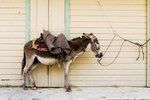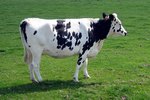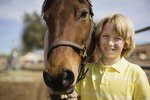
Farmers favor cattle over horses in part because oxen yokes are simple and require little repair or maintenance. Teamsters drive oxen to complete a number of agricultural and transportation tasks, using a yoke that maintains control while harnessing the power of the animals. The type of yoke used to keep a pair of oxen together varies around the world depending on the physical characteristics of indigenous cattle and the cultural traditions of the area.
Head Yoke
When using a head yoke, which attaches around the animals' horns, oxen push forward with their heads and horns bearing the bulk of their loads' weight. Historically, these yokes were called forehead yokes because the yokes were attached directly to specimens' horns. This style was popular in Austria, Germany and Switzerland but fell into disuse because cattle harnessed in this way frequently suffered serious skull injuries. Contemporary head yokes are held in place by straps around the backs of the animals' heads rather than being directly attached to their horns. These yokes rely on oxen's natural tendency to push with their heads and are common in Spain, Portugal and Latin American countries.
Neck Yoke
Neck yokes give oxen greater flexibility and maneuverability than head yokes and gives the teamster less control over the animals. The yoke sits atop the middle of the animal's neck, with curved bows wrapping underneath to hold the yoke in place. Neck yokes require oxen to push with their shoulders, necks and chests rather than with their heads. This style is an English tradition that was exported to the United States and Australia, where it is still in use today.
Withers Yoke
The withers yoke works best on humped cattle, such as those indigenous to India, Africa and southeast Asia. The yoke itself rests against the animal's hump in front of his withers, riding high on his neck. The animal's head and neck are free and his shoulders move without interference. Variations of this type of yoke are used most commonly in India, which has the world's largest concentration of working cattle.
Geographic and Cultural Considerations
While common in tropical and subtropical regions, the withers yoke wouldn't work with European oxen, which do not have pronounced humps. Despite European influence in African agriculture, native farmers found the withers yoke worked better for them than the head yokes and neck yokes favored by Europeans. Withers yokes are most accessible to poor and subsistence farmers because their simple construction requires minimal tools and maintenance. Additionally, these yokes are easily transferred between teams and don't require adjustment as the cattle grow.
References
Photo Credits
-
Hemera Technologies/Photos.com/Getty Images
Writer Bio
Jennifer Mueller began writing and editing professionally in 1995, when she became sports editor of her university's newspaper while also writing a bi-monthly general interest column for an independent tourist publication. Mueller holds a Bachelor of Arts in political science from the University of North Carolina at Asheville and a Juris Doctor from Indiana University Maurer School of Law.




